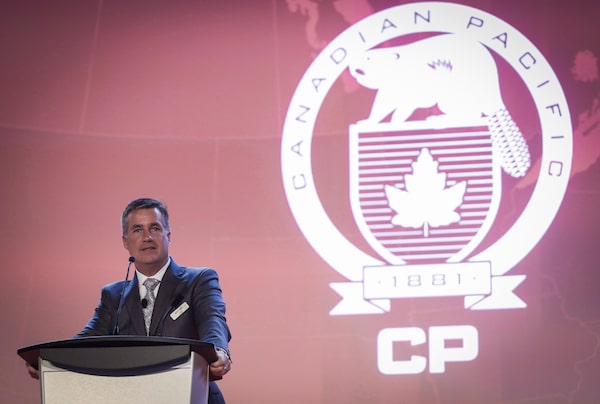
Safety pay made up just more than $350,000 of CEO Keith Creel’s bonus – he is seen here on May 10, 2017 – of nearly $3-million. Other CP managers also received the safety-based bonuses.Jeff McIntosh/The Canadian Press
When a Canadian Pacific Railway Ltd. train plunged 60 metres off a bridge in February, 2019, killing three of the company’s employees, chief executive officer Keith Creel issued a statement that called it “a tragedy that will have a long-lasting impact on our family of railroaders.”
In one important way, however, it’s hard to see much of an impact at all. About a year later, the company’s board of directors approved 2019 compensation for the company’s executives that gave them not just 100 per cent of the target bonus payment for company safety, but an above-expectations award of 122 per cent.
The company paid $6.6-million in bonuses to its six top-paid executives, and nearly $800,000 of that amount was tied directly to the company’s safety record. The safety pay made up just more than $350,000 of Mr. Creel’s bonus of nearly $3-million. Other CP managers also received the safety-based bonuses.
Should a company pay zero executive bonuses, of any kind, in a year when workers die? Many folks may say yes, but that’s arguably a high bar in a dangerous industry such as railroading. Rare is the year when CP or Canadian National Railway Ltd. can avoid having at least one fatality. CP saw another worker die in December in British Columbia. Two CN workers died on the job in 2017.
So the two have crafted pay systems where executives can get most of their bonuses purely for meeting financial targets. At CN, safety makes up 10 per cent of the overall bonus; at CP, it went to 15 per cent from 7.5 per cent in 2018. (“As safety is our top priority, in 2019, we increased the weighting of our safety measure,” CP says in its proxy statement to shareholders.)
The problem – laid bare by CP’s decision on its bonuses – is how safety is measured at both railways.
CP based its bonus-safety calculation solely on the U.S. Federal Railroad Administration’s (FRA) train accident metric – a number that measures the rate of accidents, not whether any of them actually killed an employee. (An accident is anything that causes just US$10,500 of damage to the trains or track; the definition explicitly excludes the cost of “loss of life or injury.”)
CP set a target of 1.08 accidents for every million train miles travelled, and came in at 1.06 for 2019, the company says. That merited a performance score of 122 per cent on the safety measure, the company says. And that meant CP took the portion of the bonus tied to safety and gave executives 122 per cent of their targets.
CP says it will add the FRA’s injury rate metric to its 2020 calculations, which is a combination CN already uses. So there will at least be a human component next year. But neither formula has a factor that says if an employee dies, the bonus should be zeroed out. And the compensation committee of CP’s board, which has discretion to adjust any results the formula spits out, chose not to in 2019.
Neither company would explicitly address the question of why fatalities, as opposed to accidents or injuries, weren’t part of the formula.
In an e-mailed statement, CN spokesman Jonathan Abecassis said, “Safety is a core value at our company and that is why we have set targets as part of the executive compensation package," and then pointed to the company’s proxy circular. There, CN says it “recently launched an important safety campaign that focuses on a singular goal: reduce serious injuries and fatalities to zero at CN so everyone can go home safely every single day.”
Also through e-mail, CP spokesman Jeremy Berry said the changes to the company’s bonus plan to include injuries, and said those personal injury rates at CP are at an all-time low. For the 14th straight year, he said, CP was the safest large railroad in North America, based on the FRA accident rate.
“However, we must continue to drive improvements and learn from past events,” he said. “The tragic incident in Field, B.C., on Feb. 4, 2019, is always on our minds and we are committed to continuous learning and development in the area of safety. Safety is a never-ending journey, it is not about a single destination.”
Agreed. As the boards of both railways take that journey of continuous learning about safety, they can discuss the optics, and ethics, of their executive bonus plans.
Your time is valuable. Have the Top Business Headlines newsletter conveniently delivered to your inbox in the morning or evening. Sign up today.
 David Milstead
David Milstead